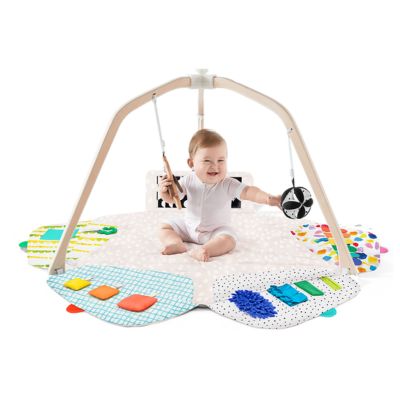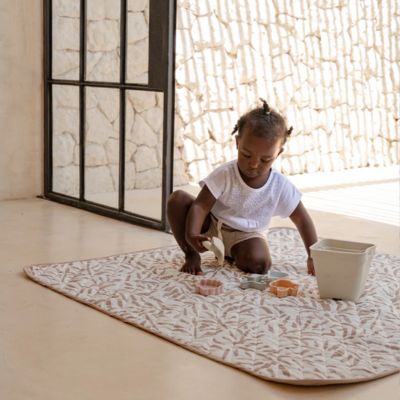I remember asking the nurse when to start tummy time on my first postpartum checkup.
It was an activity that I was familiar with. But as a sleep-deprived, overwhelmed, new mom with PPD, it sounded very scary to do.
- How can I do tummy time with my newborn?
- Do I just turn or roll her over?
- How early can you start tummy time?
- Do I do it before or after feeding?
- What if my baby hates tummy time?
This article will answer that and more.
Let’s start first with the basics.
I hope you’ll love the products we recommend! Just a quick note: if you click on a product link below and decide to buy it, we may earn a small commission.
List of Contents
What Is Tummy Time?
Tummy time is a supervised activity where you lay your baby on their stomach while they’re awake.
When to Start Tummy Time
You can actually start tummy time right after birth when you’re doing skin-to-skin with your baby!
Honestly, I didn’t know this when I was a new mom.
I thought then you had to wait for at least a month for their neck to get stronger.
But apparently, tummy time does that for your infant!
The American Academy of Pediatrics (AAP) though recommends doing tummy time when your baby comes home from the hospital.
Either way, as long as your doctor gives you the GO signal and you’re comfortable doing it in the hospital, then go ahead and do tummy time there!
Importance of Tummy Time
Tummy time is a must for your baby and offers a lot of benefits:
Develops neck control
Newborns and younger babies (0-3 months) can strengthen their neck muscles, to develop neck control, through tummy time.
This is important for learning how to roll over, sit up, crawl, and such.
Strengthens head, chest, and arm muscles
Continuous tummy time for older babies (4-7 months) can make the muscles of their upper torso stronger by practicing lifting their head and chest.
Helps meet developmental milestones
Recent research concluded that tummy time is positively linked to gross motor skills and doing lots of it can help with your child’s overall development!
This means that doing a lot of tummy time can lead to your baby getting stronger upper muscles, which can help to meet milestones, such as rolling, crawling on the carpet, and such.
Tummy time also helps develop your baby’s sensory skills as being on their tummy allows them to feel different textures (play mat, blanket, carpet, etc.) on their hands, arms, and even cheeks.
It also helps with hand-eye coordination, as it allows them to look at their hands and figure out what they can do with them and learn how to move them from this and that direction.
Helps with Torticollis
Tummy time can help with torticollis, a neck condition that can affect infants.
Encouraging your baby to turn their head in both directions through tummy time can relax their neck muscles and help treat torticollis.
Avoids flat head syndrome
Babies who spend too much time on their backs can have a higher chance of getting a flat spot on one side or the back of their head, called a flat head syndrome.
Lots of tummy time exercises can help with that, and avoid it completely.
Alleviates gas pain
The gentle pressure on your baby’s belly during tummy time can help relieve gas.
But take note to wait at least 30 minutes after feeding them, to do tummy time.
Doing it immediately, right after feeding can make your baby spit up or vomit.
How Long Should You Do Tummy Time?
In the first few weeks, you can try it for just a few minutes.
For newborns, try 1-2 minutes, then make it into 3 minutes a day.
Then build that up to 5, 10, or 15 minutes. Then do tummy time several times a day.
For older babies, around 4 months and up, you can even do it longer for than 10 minutes! For several times a day.
Do’s and Don’ts of Tummy Time
- Don’t leave your baby
Stay always with your baby during tummy time.
Never leave them alone, unsupervised.
Especially if there’s a possibility that they can roll over the bed (if they’re doing tummy time there!) or suffocate on a nearby blanket.
Take note to also clear away items that they can choke on or hurt themselves with if they’re getting more mobile.
- Do it after a feeding
Health professionals would recommend waiting for about 20 to 30 minutes after a feeding.
If possible, try to do it a bit longer than that, say 45 minutes or so.
Placing your baby on their tummy right after they feed can cause them some discomfort or vomiting.
So just wait for half an hour or maybe more (just to be sure!), before laying them on their tummy.
- Do start slow
Start with just a minute or two of making them lay down on your chest.
If you see that they’re not getting fussy, do it a bit longer.
Then do it several times a day, a few minutes longer.
- Don’t do it when they’re sleepy or hungry
Your baby will absolutely hate doing tummy time when they’re hungry and/or tired.
And you don’t want them to associate tummy time with those feelings.
So only do tummy time when they’re alert and you’ve waited for 30 minutes or more after feeding them.
- Do provide some tummy time toys
Give them something to look at, to encourage them to do more tummy time.
You can place them in their baby play gym and let them look at the toys that come with it.

Or you can grab some stuffed animals, high-contrast flashcards, or a propped-up baby book, then put that in front of them!


- Do it anywhere appropriate
Try tummy time in all sorts of places – in your garden outdoors, in a park, etc.
This is a way for your baby to explore their environment and learn a lot of things from it!
Just set up an outdoor playpen or playmat and your baby is good to go.


- Don’t do it when it’s sleeping time
Tummy time is an activity for alert and awake babies.
You should never place your baby on their tummies for sleeping, for their safety, to lower the risk of SIDS.
How To Do Tummy Time?
For Newborns
Check out this video, right at the 35-second mark, on how they turned over a newborn for tummy time:
You can also roll your infant to a tummy time position like so:
I was nervous doing this the first time but you’ll get the hang of it eventually. Cause you’ll be doing it several times a day!
You can also place them on your chest while you’re laying down in an inclined position. This is the easiest tummy time to do with your newborn!
But the best way to do it is on the floor, on a clean blanket, or play mat,) with you supervising and encouraging them.
Do it for a minute or two. Then do that 2 to 3 times a day.
Then as your newborn gets more comfortable doing tummy time, do it longer than a few minutes, several times a day.
You can actually lay them anywhere comfortable, eg., bassinet, mini crib, your bed, play mat, etc., as long as you can supervise them all the time.
For Older Babies
For 4 months to 7 months old, you can still place them on your chest if you want.
But at that age, I bet they would want to see more than your face!
Kidding aside, you can place them on a playpen, playmat, or even on a clean crawling rug or carpet!
You can place them anywhere, as long as there’s no object for them to choke on or suffocate on and the surface is relatively clean.
For Babies with Torticollis or Flat Spots
Do it the regular way but this time, encourage them more to turn their head or gently help them turn it.
To further avoid flat spots and to relax their neck muscles.
Tummy Time Activities
Here are some tummy time activities and ideas that your baby will find fun and interesting:
- Lay them on your chest
This is probably the best way to do tummy time with your newborn, especially when you do it skin-to-skin.
Your baby will love being near you and they’re so close for some kisses and snuggles!
- Lie down in front of them
Your baby loves seeing and being close to you.
And what better way to encourage them to do more tummy time than with their parents, hanging out in front of them!
Check out the mom below and see how she talks and encourages her baby to do tummy time:
- Put safe toys and objects around them
A one-week-old baby can already see some colors and such at about 8-10 inches away.
At 6 weeks, your baby can already see about 12 inches away.
So by then, you can already place some high-contrast cards, some wooden baby toys, or just some safe objects close to your baby!
You can put those objects right in front and around them.
This will encourage them to look in front and from side to side.
You can also just prop a book, place a stuffed toy or a mirror, or some sensory items that are safe for your baby to grab.
Just remember to always supervise your baby, especially when they’re getting more mobile to grab an object!
- Place a towel or small pillow under their armpits
Try rolling up a small towel or use a small bolster pillow and place that under your baby’s armpits and forearms.
This gives your baby a whole new perspective on their environment. Plus it makes it easier for them to lift their head and push it up.
Check out more tummy time activities for newborns and older babies here.
What To Do If Baby Hates Tummy Time
- Do several shorter stints a day
If your baby is not a fan of tummy time, try doing it for just a minute or two at first, in the first few days.
Then gradually make that longer.
- Change locations
Make them do tummy time on the living room floor. Or in the garden on an outdoor playpen or playmat.
Or just anywhere clean and safe, with some interesting things for them to get distracted with.
- Massage their feet
Your baby might like doing tummy time while you’re giving them a foot massage!
It’s also a great way to distract them when they don’t like doing tummy time.
- Let your other kids join in
If you have other older kids, ask them if they can join your newborn on the floor for some tummy time.
A fresh face can hopefully make tummy time more fun for your little one.
- Change the toys
Try a different high contrast card, put family pictures, or use a rattle or any new toy that they might find interesting.
Tummy Time Alternatives
- Try football hold
If your baby hates doing tummy time on the floor, try doing the tummy down carry.
Check out this video at the 1:42 mark to see how to carry them football-style
Most important thing is that their head and shoulders are still supported in this position.
You can carry them closer to you for added support.
- Lay them across your lap
You can also try to sit down on a sofa then turn your baby and place them belly down your lap.
You can use a blanket or pillow and then place some toys in front of them.
Or you can have your spouse or other family members talk to them and encourage them!
It’s a new position for your baby so hopefully, they’ll be able to tolerate it.
- Try babywearing
Babywearing can be a form of tummy time but it can’t replace the benefits of getting down on the floor for your baby to do a proper tummy time.
Still, babywearing puts your baby in an upright position that allows them to develop their neck and back muscles.
And just to let you know, babywearing also helps with reflux!
Tummy Time for Reflux Babies
If your little one is suffering from reflux and finds it extremely comfortable to do tummy time, try finding that sweet spot before they feed, before they realize that they’re hungry.
It can be quite tricky because of timing and other unpredictable factors.
But if you can manage it, squeeze in a few minutes of tummy time in that very short window.
You can also use a gym ball.
Place a soft blanket on it and let your baby lie on it while holding them securely at all times.
Then gently and slowly roll the ball back and forth while talking and singing to your baby.
Tummy Time FAQ
How early can you start tummy time?
There are 2 options for starting tummy time early.
One is, doing it right after giving birth!
If you’re comfortable doing skin-to-skin with your baby on your chest in the hospital, that’s already a form of tummy time.
Another school of thought of when to do tummy time is when your baby comes home from the hospital.
Settle down at home and once you’re ready, you can start giving your newborn a minute or two of tummy time.
How do you do tummy time with a newborn?
You can do tummy time with a newborn by doing skin-to-skin on your chest or laying them down on the floor with a blanket or play mat.
You can lie down with them to encourage them to have tummy time.
Is 2 weeks too early for tummy time?
No, 2 weeks is not too early for tummy time.
Some healthcare professionals would actually advise to do tummy time right after giving birth.
Others would recommend doing it when you go back home.
Is tummy time best before or after feeding?
Tummy time is best after a feeding BUT only after waiting for 30 minutes or so, to make sure that your baby doesn’t spit up or vomit their milk.
When to Start Tummy Time: Wrapping Up
I did tummy time when my baby was 1-month old.
I didn’t know then that you can do tummy time when you get home! Or even when you’re in the hospital.
With my CS and back operation though, I couldn’t do tummy time with her on my chest as I can’t even lie down on my back then.
I always had to sleep on my side on the couch as I find the bed extremely uncomfortable and even painful at times.
Those memories still bring me a tinge of regret and sadness.
I digress.
Doing tummy time can be a bit awkward and difficult at first but like everything else, you and your baby just need some practice to get used to it.


